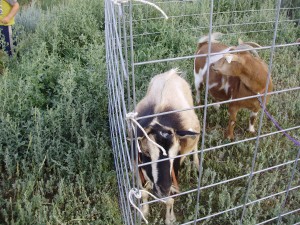This page may contain affiliate links. As an Amazon Affiliate, I earn on qualifying purchases. Please see our disclaimer for more information.
This post was originally published in July 2013.
Having a goat on pasture, or browse, is the most economical way to feed them. The person I got my goats from had a two-thousand-plus acre ranch that she turned the goats out on. She only fed hay during the roughest months of winter. We only have two acres, which means we had to figure out a different feeding system – a goat tractor.

You may know that we recently added seven goats to our little place. You can meet all of the goats in this post.
Goats are ruminants. Ruminants have a stomach that is divided into four parts. Ruminants include cattle, sheep, deer, antelope, bison, and a few other animals. These animals’ stomachs are designed to digest grass, forbs, and other browse.
While we were in the process of buying our goats and having their medical testing and other things done, I started researching purchasing hay.
I quickly found that is not an easy task in my area!
With last year’s drought and this year still being a little dry, I struggled to find a source for hay. A friend did give me a number to a guy just down the road from me that brings in hay from other areas. I was hoping to find small (read, manageable) bales of hay, but he only had bales that were 800 pounds or more. We ended up purchasing a bale that was a grass/alfalfa mix and weighed 1,100 pounds. Getting that out of the truck and into location was quite an adventure! Joe finally managed to get it where we wanted, after wiping out the fence and spending a good two hours trying to move the bale using the pickup truck. The bale of hay cost $140, which seems like a lot to me, having never bought hay before.
In addition to the hay, we had been taking a couple of the girls out for a walk each evening for about half an hour or so. We only walk two of the goats since the others are not as comfortable with us and tend to take off rather than walk and eat. While I was gone on my trip, Joe did not take them out since the girls don’t mind him quite as well as they do me. They all ate a lot of hay while I was gone. Our big bale is almost one-third gone.
Rotational Grazing
As soon as I returned from my trip, we put together a Goat Tractor. Inspired by Joel Salatin and his intensive rotational grazing practices the goat tractor is designed to put the goats in a specific area to browse and fertilize the ground. Then, the tractor is moved to a fresh area. We have successfully done the same thing with chicken tractors for the past three years, also inspired by Salatin.
When I first started thinking about a goat tractor, I envisioned something similar to our chicken tractor – only larger. I did a web search and didn’t come up with much. Then, I finally found some examples of portable goat pens on a Dwarf Nigerian bulletin board. Here is our end result.
This is two 16-foot cattle panels cut in half. The panels are around four-feet high, which works well for our Dwarf goats but might not work for a full-sized goat. Since the panels were cut in half, each side is eight-feet long. This is NOT a lot of space for the goats, but it is a manageable size for me to be able to move on my own.
We put two goats in at one time. If I put Peanut and Caliente in, we also add Knee-High (Peanut’s baby). We leave the pen in the same spot for no longer than 1.5 hours. At that point, they have eaten everything they want in that area. Then the pen is moved to a new spot simply by picking up two sides (if two people are available) or “walking” the pen to fresh grass. We keep fresh water in the pen and also have a sun shade that can be attached with large binder clips if needed.
So far, we haven’t put the boys in the pen. Joe is still working with them to calm them down a bit. They are still quite nervous. In the meantime, we take the food to them. In addition to their hay, we spend several minutes each evening picking/cutting suitable weeds and grasses for the boys.
Easy Assembly
The panels are wired together on three sides (Joe used some wire off our fencing), and the fourth side acts as the door. It is currently put together with four pieces of rope and tied in a box knot to hold it shut. We might change this closure in the future. This is a super simple process, and the total cost was just over $43 including tax. The sunshade is a piece of tarp-like material that used to cover our dog kennel before the wind took its toll. It ended up in several pieces that I saved, thinking we’d have some use for it.
If the Goat Tractor continues to go well, we might put a second one together. With it being such a small pen and needing to be moved often, it does require someone to be around in order to use it properly.
So far, I’ve been putting the three white goats in late afternoon. I move it once or twice. Then, we take those girls out and put Kalena and Cocoa in it. Joe has to help me with those two since Cocoa doesn’t think much of being put on a leash and walked to the pen. She loves it once she’s in it, though. We always keep Cocoa with Kalena since she is her buddy. Usually, we’ll move those girls once or twice before taking them back to their permanent pen (another challenge with Cocoa).
We only use the tractor during the day time; the goats sleep in their permanent pens at night, which has a shelter. We did wonder how well it would work on windy days, but a couple of nights ago we had a severe thunderstorm with wind, rain, hail, and rushing water. The next morning, the tractor was still standing, which was a good thing.
I have noticed that, even though the goats have a pen full of browse, that they often reach through the pen to get the green stuff outside. Apparently, the grass is always greener outside of the pen.
As already mentioned, my goats are not full-sized goats. You can see in this picture with my little boy that they are on the small size. I’m not sure a set up like this would work for full-sized goats. I do think something similar would work for sheep and am already planning a portable sheep tractor to try in the future. Of course, that means I need to convince my husband that (seasonal) sheep are a good idea. 😉
More Articles You Might Enjoy:
- The Preserving Your Harvest series (May through October)
- How to Package Items for Long-Term Food Storage
- Harvesting Rainwater: How to Get Started Today
- Caring for Baby Chicks
- Around the Homestead: 20 Acre Work in Progress
- Preparedness and Homesteading Resources















I have thought about doing something like this with my full size goats, but maybe 16×8. I bet that a metal carabiner clip would work well for the corners of your pen. I use them for gates and stuff with my goats, because they are easy to lock and unlock and very secure. My local hardware store has them in stock, so I bet yours would , too.
Hi Brooke,
I was thinking those clips would work also. I just need to remember to pick them up when I’m in next time. Our little tractor is working very well, so well we’re going to make a second pen so we can have more goats out at one time. I’m not sure how it will work for our buck. He is a little harder on fencing than the girls are but we’re going to give it a try one time when Joe is around to help in case something goes wrong.
We did the same thing this year, but with less success: we used 4 full sized panels, then cut squares out of the corner to mount them over tires, in which we concreted fence posts. It’s very huge & hard to move, and we have 1 little booger that repeatedly escapes–and in a different way every time. He’ll actually squeeze through the panels (that will hold him all day long in his “normal” pen–just not the portable one). Glad to see your system. We might need to make some modifications.
Hey Chaya,
I have been fortunate not to have any escapes yet. I do suspect it will happen at some point. Yesterday we put our buck and wether in for the first time. I was worried they might knock it over but they did great. My system is super duper simple which is what I love about it. And very easy for me to move on my own.
Are you in Montana ? Seems like I have seen that landscape with my son, John.
Paul
Hi Paul,
Wyoming. It does look a lot like some parts of Montana.
How did the goat tractors work out for you?
Hi Julia,
They worked great for us. Keep in mind, we have Nigerian Dwarf goats. I don’t know they would work for full-sized goats. 🙂